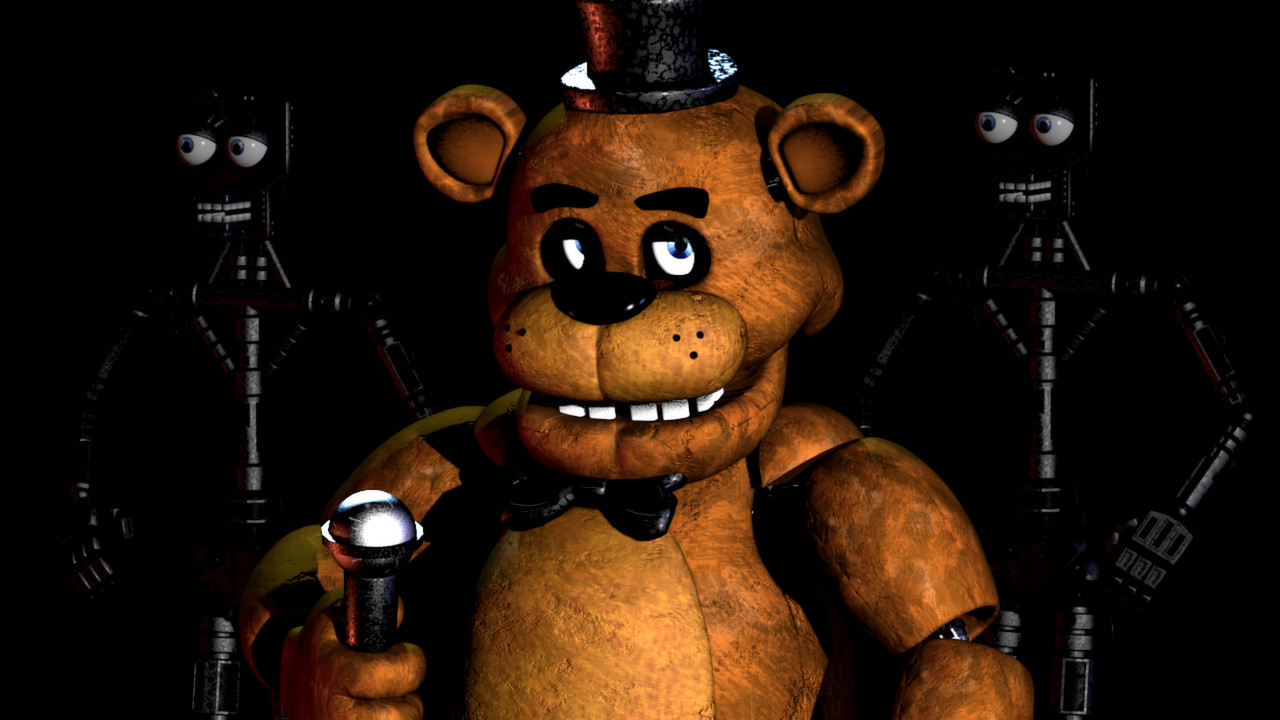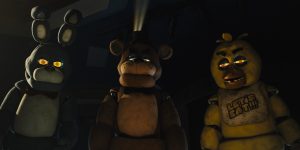
The success of the Super Mario Bros. Movie in 2023 is a hell of a thing. It took so many years for Hollywood to realize that just taking one of the most popular video game franchises ever and translating it to the movie screen in the most basic way can net them a ton of money. They figured this out with comic books years ago, but only now are they realizing that maybe you can use that same strategy with games instead of giving a middle-aged man a silly haircut and claiming he’s supposed to be Bowser.
Now in the latter half of the year, we get a video game movie from the other side of the spectrum. Instead of video games’ golden boy, it’s the little indie series that could. Five Nights at Freddy’s, an inexpensive breakout gaming hit from nine years ago, has a movie coming out that not only seems to be as source-accurate as you can get but even has the Jim Henson Creature Shop making some of the most beautiful practical effects we’ve seen in quite some time.
Hell, not only is Five Nights at Freddy’s a movie people have been waiting almost a decade for, but it’s already been the victim of knockoffs twice in the last four years. Both The Banana Splits Movie and Willy’s Wonderland were extremely blatant attempts to eat Chica’s lunch before the real deal could hit theaters.
How did we get to this point? Why is this game series such a phenomenon?
The Origins
The way Scott Cawthon created Five Nights at Freddy’s feels almost like a supervillain origin story. Back in 2013, he released a game called Chipper & Sons Lumber Co. It was a mobile title that featured an art style that was somewhere between Rare N64 platformers and one of those godawful CGI straight-to-DVD ripoff movies your grandma is tricked into buying you because she thinks it’s a Pixar film. People razzed him for the visuals, talking about how outright creepy the characters appeared. Cawthon was like a clown trying his best at a birthday party, only to find nothing but crying and screaming children. Depressed over the criticism, Cawthon ended up finding inspiration in how unnerved everyone was over Chipper and the rest.
Released on Windows on August 8, 2014, Five Nights at Freddy’s was simple, but incredibly effective. You play as a lowly and unseen security guard, working at a Chuck E. Cheese pastiche called Freddy Fazbear’s Pizzeria. At night, the animatronics are free-roaming and incredibly dangerous. Said animatronics also happen to look an awful lot like the characters from Chipper’s world but in a darker atmosphere. Of course, the game does not take itself too seriously and there is a lot of morbid humor in there, usually in the form of the rather flippant guy on the phone giving you directions and context.
Surviving the night means keeping an eye on the whereabouts of the different rogue animatronics and closing the nearby doors when necessary. Mind you, electricity is a finite resource that will run out if you misuse it. It’s a plate-spinning situation where failure means a heart-stopping jump scare and game over.
The game became a runaway success that spawned so many sequels that we would sometimes get multiple entries in a year. The formula would be altered and expanded over time, including the ever-increasing cast of metal beasts out to scream at us out of nowhere. What made that formula so appealing in the first place, though?
The Scares
The Five Nights at Freddy’s games have some disturbing themes (more on those in a second), but what really helps make them work is that they aren’t especially violent or gory. All the vicious stuff is either implied or shown in primitive pixel form during cutscenes. You aren’t going to see any vivid George Romero brutality, but the sudden scares and the suggestions of what is happening carry the weight. It’s all about the tension.
That approach opens these games up to a wider fanbase. As long as they have the courage, kids can enjoy what Five Nights has to offer without everything seeing anything R-rated. Sure, one of the games may feature imagery of a man in a mascot costume accidentally getting impaled to death dozens of times over, but when it looks and sounds like it’s coming from an Atari, it’s so inoffensive and palatable. Yes, the big plot point involves multiple child murders, but even Disney owns Star Wars.
There’s also something to be said for how that approach has impacted the games’ marketing. It’s a franchise that operates on different planes of existence. There is a ton of merch out there for Five Nights including clothes, figures, plushies, board games, keychains, etc. and it all represents different layers of what these characters are supposed to be. Are they lovable corporate mascots? Creepy murder machines? Somewhere in-between, laced with irony? It’s a versatile property.
However, one of the biggest reasons the game took off so quickly was the influence of various Let’s Play YouTubers. Now, Let’s Play and reaction-based YouTube videos can be a divisive concept, but as someone who genuinely enjoys watching the Game Grumps look like idiots playing Wheel of Fortune or seeing someone lose their mind over the ending of Sixth Sense, I can understand why Five Nights at Freddy’s caught on so well.
Those Five Nights at Fredy’s Let’s Play videos were about empathy. They were about connecting through an experience. It’s like showing somebody a funny video off your phone and getting enjoyment out of their laugh. Whether you’re watching Markiplier, PewDiePie, or WWE wrestler Big E, there’s entertainment in watching somebody get sucked into the tension, only to suddenly freak out because a robot bunny just popped out of nowhere and let loose an unearthly scream.
I cannot overstate how valuable those types of empathetic videos were during the pandemic. In that extended time when everyone was boxed up, miserable, and separated by six feet and plastic shields, unable to spend quality time with loved ones in person, just seeing somebody feel – even if it was panic and fear – was therapeutic and acted like a placeholder for actual human interaction.
The Lore
On the surface, the world-building of Five Nights at Freddy’s is complicated and ill-defined. Yes, we’ve seen complicated lore in games like Kingdom Hearts and BlazBlue, but those games usually explain nearly everything upfront and it only gets complicated when it’s all piled up over countless hours. Most of Five Nights’ story exists under the surface in increasingly abstract ways.
For instance, the first game has a pretty basic story about trying to keep away from malfunctioning robots so you can stay alive and earn a meager paycheck. It seems straightforward. However, an Easter egg featuring newspaper clippings that talk about a series of child murders suggests that the victims’ bodies were crammed into the animatronics. Suddenly, there’s a twist that suggests these robots aren’t simply on the fritz but are haunted by the ghosts of murdered children!
That put a new layer on the story, but there was still so much left unexplained. The following sequels started adding cutscenes and minigames (some of which were hidden) using Atari graphics that gave the lore some context that was confusing and up for interpretation. This included revealing the murderer as a purple Atari sprite (nicknamed “The Purple Guy” by fans and later identified as William Afton) and the twist that the second game was actually a prequel. The third game seemed to close the door on the franchise, though without explaining every lingering question.
By the fourth game, things got really weird. Instead of the security guard angle, you played as a scared child, hiding in his room and trying not to be attacked by nightmarish variations of the Fazbears animatronics. By reading between the lines, you could decipher that the entire game was a fever dream of a dying child, killed from a prank gone wrong at a birthday party.
From there, the series really started to go off the wall. Filling in the blanks on lore meant more hidden games, searching the HTML code on the official website, watching a cartoon soap opera about Dracula’s baby, figuring out clues in an in-universe activity book they released in the real world, etc. Not to mention the many, many novels that gradually became more important.
Soon this series that started as a simple ghost story led to some ridiculous concepts like dead humans being replaced by robot duplicates, a character having various animatronics being shoved into his body and being turned into a zombie as a side-effect, and people playing VR versions of older games until being taken over by William Afton’s digital soul. It’s a lot. Especially since the newest game, Security Breach, allows you to freely wander an entire facility with lore breadcrumbs hidden all over the place.
You’d think it would be too much, but believe me, the fans go nuts for this. Ultimately, that’s the point.
The Fanbase
I could go on about the legions of Five Nights at Freddy’s enthusiasts making fan art, fan theories, fan animations, and so on, but that stuff is expected. That’s what just about any passionate fanbase does. That said, my personal favorite fan-created thing is this video by Recursive Sweatpants where Freddy and the others run afoul of the newest security guard: The Pyro from Team Fortress 2.
I guess they don’t believe in magic.
One thing that sets Five Nights apart from other fandoms is the excessive amount of fan games and ripoffs out there. There are so many. It’s unusual but it makes sense. Successful or not, the original games were no AAA affair. They were low-budget efforts that used limited resources to optimal effect. If someone was skilled enough in terms of programming, they could easily ape that kind of style and add their own personal touch.
Through the years, there have not only been games based on the Freddy Fazbear universe, but also original characters in the same art style, a cartoon egg named Flumpty, nightmarish Disney animatronics, and, for some reason, the mascot from Jollibee. Which is fair, because it is kind of creepy, but I’d gladly risk mutilation in the name of that delicious fried chicken.
What’s great is that Cawthon was really supportive of all of this. Well, mostly. Some people went a bit over the line by using Five Nights assets and trying to make it seem official. Otherwise, he was excited about the passionate creators and even celebrated it in 2020 with the Fazbear Fanverse Initiative, where he helped fund various sequels and remakes.
And of course, with each little piece of Five Nights media being its own scavenger hunt for lore, that’s turned the fanbase into one giant tornado where every single thing is gone over with a fine comb. It’s created a whole “chicken and egg” situation where the hidden lore feeds the fans and the fans feed the need for more elaborate lore. It is possible that it’s getting a bit too oversaturated, like with the Marvel Cinematic Universe, where there is just too much to keep track of and the world-building is too out of control, but I guess we’ll have to see when that bubble pops.
Seriously, though, there used to be just four dead kids back in 2014. I’ve lost track of what the body count is at this point. I think there are enough murdered children to put together a haunted orchestra.
It’s funny to think that all of this started with Cawthon being sad that people thought his earnest video game was too creepy. Now, he’s owning it and asking everyone to celebrate it with him. A simple game based around pointing and clicking played its strengths so well that it’s now hitting theaters. And hitting theaters at the right time, too! Days before Halloween! See how easy that is, various Haunted Mansion movies?!
With so much content still being cranked out, it’s hard to predict how long the Five Nights at Freddy train can keep chugging along so strongly. But you know what? It takes a lot of confidence to center your horror franchise around a guy named Freddy and that kind of attitude will get you far.
The post How Five Nights at Freddy’s Earned Its Cult Following appeared first on Den of Geek.







